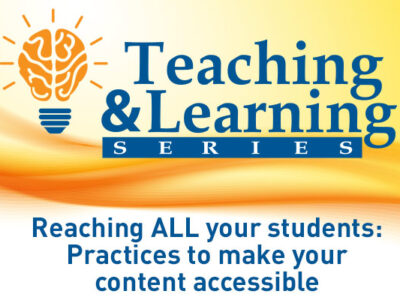Accessibility in education not only supports students living with a disability but is better for everyone. How we think about accessibility, though, is impacted by the ways in which we think about disability. When we hear “disability” we often think of it as something that is internal to the person…physical limitations or conditions that are located within the body. That is the medical model of disability by which issues relating to access is a personal problem. This approach applied to a learning environment does little to promote a positive student experience.
Social Model
If we are willing to change the script on disability, however, and look at it from a social model perspective, we start to think about access differently. The social model of disability was introduced by Mike Oliver (2014) in the early 1980s, building on the disability movement that emerged in the UK a decade earlier. Oliver used this model to posit that people with disabilities are “not disabled by [their] impairments but by the disabling barriers [they] faced in society” (Oliver, 2014).
That is not to dismiss the impact of impairment or to minimize the bodily experience but encourages an examination of how external factors renders someone as disabled. Once we understand systemic, environmental, social, and attitudinal barriers, then we can think about what we can do collectively to create a society without barriers where everyone can fully participate.
Universal Design for Learning
Universal Design for Learning (UDL) is an educational framework that strives to avoid barriers in education from the beginning. While some students may still require specific accommodations, the UDL approach is intended to help create instructional content that is accessible to a broader student base, not just the average, expected learner (Bedrossian, 2018). Accessible elements are not an “add on” but rather embedded components of the instructional design. The UDL model anticipates that people learn in many different ways benefitting many students, not only ones who formally identify has having a disability (Bedrossian, 2018).
Better for Everyone
Imagine an architect designing a building for a small lot where there is not enough room for steps and a ramp leading to the front door. If the architect then choses the ramp instead of steps, the building’s entrance is then fully accessible – both able-bodied people and people who use mobility devices can enter the building. The added bonus is the that the ramp also supports people who may have temporary impairments – like someone who is recovering from knee surgery. It also supports someone who may be pushing a stroller or making deliveries. The steps only allow a percentage of people to enter the building, but the ramp is good for a wider range of access.
Once we create an accessible learning environment, then we must ask, “But is it inclusive?” However, that is a topic for another day!
Bedrossian, L. (2018). Understand and promote use of Universal Design for Learning in higher education. Disability Compliance for Higher Education, 23(10), 7–7. https://doi.org/10.1002/dhe.30435
Oliver, M. (2013). The social model of disability: thirty years on. Disability & Society, 28(7), 1024–1026. https://doi.org/10.1080/09687599.2013.818773
External Resources:
CAST is a nonprofit education research and development organization that created the Universal Design for Learning framework, now used the world over to make learning more inclusive. Visit CAST’s resource rich website.
Tobin, T. (2014). Increase Online Student Retention with Universal Design for Learning. Quarterly Review of Distance Education, 15(3), 13–24.
Tobin, T., & Behling, K. (2018). Reach everyone, teach everyone: Universal Design for Learning in higher education. West Virginia University Press.
UWindsor Resources:
Accessible Content Cards – Reference cards created by OHREA and accessible committee members. Tips on how to make your digital content more accessible.
Read & Write – The University has purchased an institution-wide licence for Read & Write software which supports reading, writing, and research by making documents and files more accessible. The software is free to all UWindsor employees and students.
EquatIO – The University has purchased an institution-wide licence for EquatIO. EquatIO makes it easier to create equations, science symbols, chemical formulas, or other mathematical expressions digitally. This software is free to all UWindsor employees and students.
Video Tutorial on adding and editing subtitles in Microsoft Streams.
Video Tutorial on automatically caption YouTube videos.
UWindsor Wiki page on captioning videos.
Cherie Gagnon is the Accessibility Manager in OHREA and has been involved in the disability community for 20 years in many capacities. She has extensive board experience and is a founding member of Microboards Ontario which supports people with disabilities to direct their own lives. In addition to representing the family voice locally, she was appointed by the Minister of Children and Youth to sit on an inter-ministerial reference group overseeing implementation of the Special Needs Strategy. As a UWindsor Alumni, and a graduate from the University of Calgary Masters in Disability and Community Studies, Cherie is enjoying the opportunity to work at her alma mater to support an inclusive and accessible experience for students and employees.






Comments